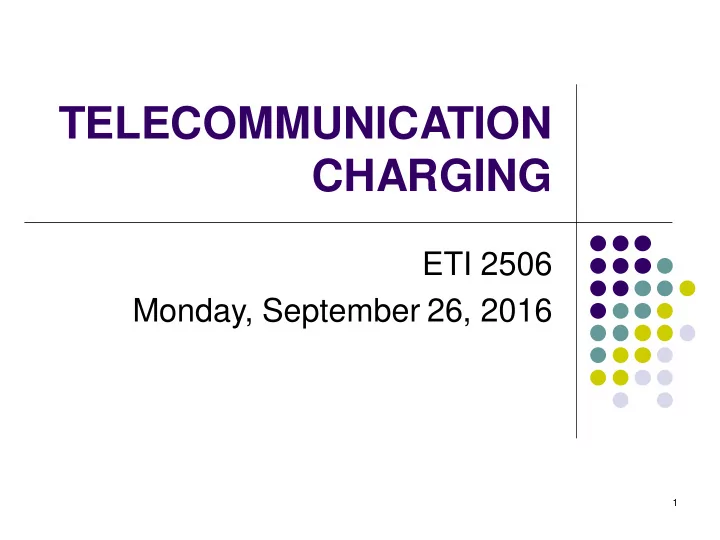

TELECOMMUNICATION CHARGING ETI 2506 Monday, September 26, 2016 1
WHY WE NEED A CHARGING PLAN? Providing a telecommunication service calls for 1. investment in capital items as well as meeting operational expenses. The capital cost includes that of line plant, switching 2. systems, buildings and land. Operating costs include staff salaries, maintenance 3. costs , water and electricity and miscellaneous expenses. A telecommunication administration receives its 4. income from its subscribers. A charging plan provides for recovering both the 5. capital costs and the operating costs from subscribers. 2
CALCULATING THE COSTS The cost of shared resources like the switching 1. equipment is amortised among a large number of subscribers over a period of time. The cost of dedicated resources like the 2. telephone instrument and the subscriber line must be recovered from individual customers. The operating costs must be worked out 3. depending on the quantum of resources used in providing a service and the duration for which these resources are used. 3
CHARGES LEVIED ON A SUBSCRIBER A telecommunication service can levy three categories of charges to a subscriber: 1. An initial charge for providing a network connection: 2. A. rental or leasing charge 3. Charges for individual calls made. 4
OTHER CLASSIFICATION Operating costs for telephone exchanges and 1. transmission networks. Government policy e.g. policy on subsidy of 2. local calls by trunk/international calls, taxes or USO. Communication regulations , e.g. CAK’s 3. guidelines on interconnection. 5
CHARGING METHODS FOR INDIVIDUAL CALLS Duration Independent Charging 1. Local calls in the fixed Networks are usually charged on a duration independent-basis. The subscriber meter is incremented once at the start of a local call. Duration Dependent Charging 2. Periodic pulse train of pulses from a common pulse generator operate the subscribers meter. Modern exchanges store date, time and duration in seconds for the purpose of charging. 6
DISTANCE-RELATED CHARGING 7
TARIFF VARIATION Telephone exchange capacity is based on the 1. estimated capacity at the busy hour. As a result, a large part of the capacity remains 2. idle during off-peak hours. Most operators lower tariffs to encourage 3. subscribers to call at off-peak hours 8
EXAMPLE OF TARIFF VARIATION SCHEME 9
EXAMPLE A telephone administration provides leased lines at the rate of Kshs. 600 per km for a minimum rental period of 3 months. MMU, a point-to-point traffic user, has offices located 600 km apart and is confronted with the choice of using Subscriber Trunk Dialing (STD) or leased lines. At what traffic volume per day, should the organization move from STD to leased line? Assume 20 working days per month and a rate of Kshs. 1 per unit recorded by the meter. Assume that STD calls are charged at Kshs. 20 per 10 minute.
SOLUTION Cost of renting the leased line is 600 x 600 = Kshs. 1. 360,000 Cost of STD calls per hour is 60 X 20 = Kshs.1200 2. Let the break-even point occur when the STD line 3. is used for x hours in three months. Then we have 1200 x = 360,000, or x = 300 hours in 3 months = 100 Hours in a Month = 5 hours per day 11
Common Channel Signaling ETI2506 Monday, 26 September 2016 12
TELECOMMUNICATION NETWORK SIGNALING Exchange Hierarchy Classification 1. Subscriber loop signaling Intra-exchange or register signaling Inter-exchange or inter-register signaling. Channel-Level Classification 2. In Channel Signaling Common Channel Signaling 13
SIGNALING TECHNIQUES 14
COMMON CHANNEL SIGNALLING Signaling Modem 15 Terminal
CCS SIGNALLING FRAME FORMAT Error Signalling Circuit Header Check Information Label 16
COMPARISON OF IN-CHANNEL AND COMMON-CHANNEL IN-CHANNEL COMMON-CHANNEL • • Trunks are held up during signalling Trunks are not required for signaling • • Interference between V oice and Control No interference since the voice and control Signals may occur channels are separate • • Separate signaling equipment is required in Only one set of signaling equipment is each trunk hence expensive required for a large group of trunk circuits hence economical • • Can be misused by customers since it is Control channel is in-accessible to users easy to mimic voice signaling • • Signalling is relatively slow Signalling is much faster • • Speech circuit continuity is assured when State of speech circuit not automatically signaling is received assured • • It is difficult to change or add signals There is flexibility to add or change signals 17
Recommend
More recommend